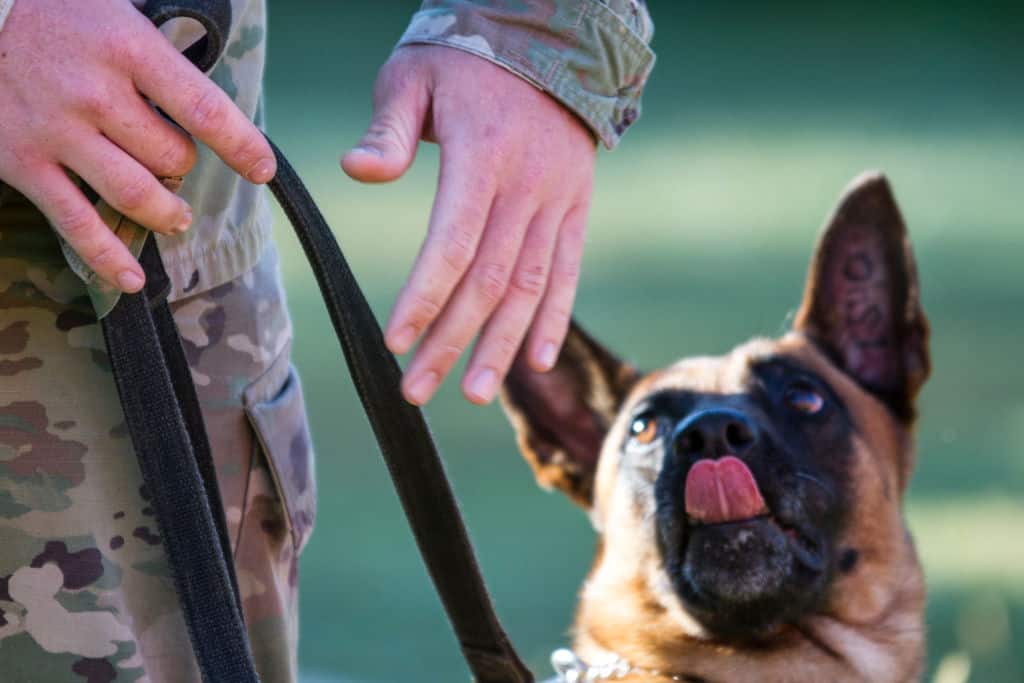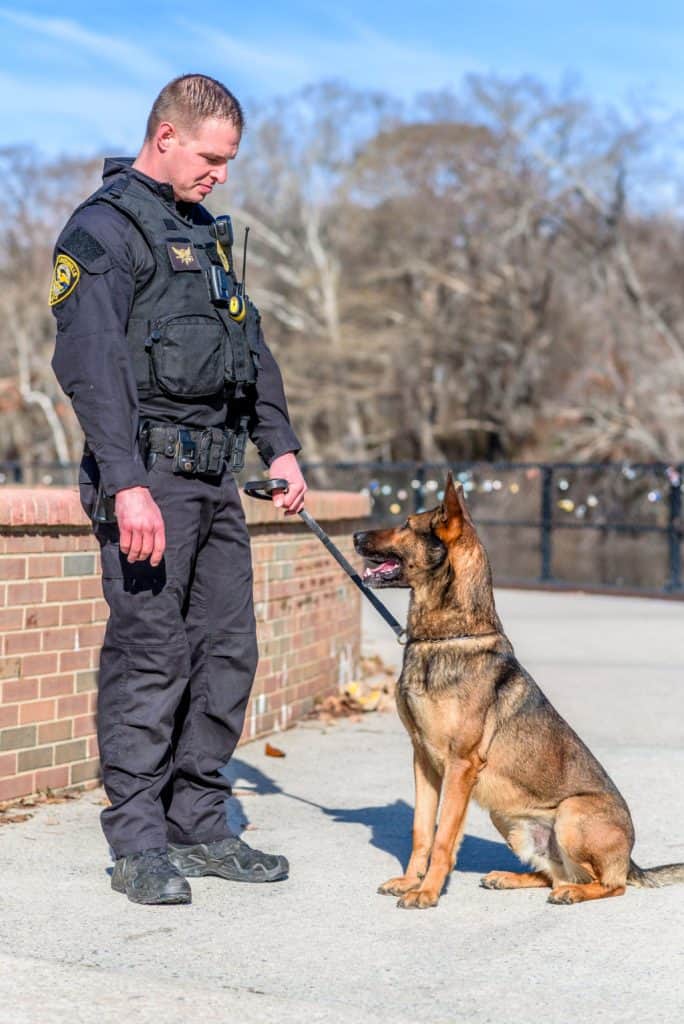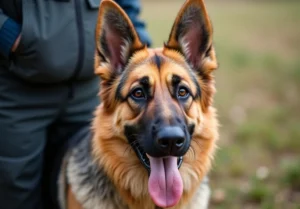Conditioning is the primary reason why police dogs do not chase after cats. Police dogs understand that the focus is on the job, whether a suspect or an object, not another dog or cat. They have been extensively trained to ignore and focus on the task for at least four to eight weeks, typically much longer.
They spend a lot of time learning to stay focused on their task and not get distracted by a cat, another dog, or a piece of random food on the ground during their intensive training before working in the field.
Consistency in the training regimen is vital. For instance, trainers often expose the dogs to live cats in controlled environments, ensuring the dog understands that the cat is not the target.

How Do They Train Police Dogs to Behave?
Police dogs are taught from the time they are puppies. It begins at the age of one year. The defense drive and instinct to hunt and seize prey are essential characteristics of a competent K-9 dog. This is a key component in a police dog, which is why many police departments will not fix their dogs.
When working or being given a command, police K9s are often taught to ignore other animals. These canines are trained to use their instincts on order and under supervision.
Police K9s are recognized for their efforts, like most other working dogs. They are also bred to be healthy and smart, which isn’t true of all show dogs.
Moreover, police dogs often undergo scenario-based training. Here, a controlled environment is set up where a cat might suddenly cross their path during a mock chase, reinforcing their ability to stay undistracted.
For example, in Lancaster, Texas, the dog and the handler must attend at least 4 to 8 weeks at a dog training school where they will learn to work together. Obedience training comprises searching, tracking, and obeying commands.
Generally, when working in houses, police dogs are given exposure training, including exposure to going into a house to clear it with a dummy dog or cat. Some police dogs will learn to wear prong collars, but only in certain scenarios where quick direction is critical.
Avoidance is a practical approach for training K9s. If other loose dogs or cats are hostile in a house, they are relocated, or the dog will not be sent in. A K9 may overlook another dog or a cat, but he will not ignore a hostile animal.
It’s worth highlighting the importance of post-training evaluation. Before police dogs are certified for fieldwork, they’re tested in various real-life situations to ensure they won’t get distracted by animals like cats.
The real truth in police work is this: Cats aren’t a problem because they usually leave or run away. Police dogs follow their handler’s directions and act appropriately. A badge would never be given to an unstable dog, and most have a balanced temperament to learn and behave.
Interestingly, while the police dogs are trained to avoid distractions from animals like cats, the bond they share with their handler plays an equally crucial role. This trust ensures the dog focuses on the handler’s command more than any external stimulus.
Why Do Some Dogs Attack Cats?
Some dogs regard cats as prey, and this type of behavior is known as predatory aggressiveness. Hunting cats is no different for them from hunting rats, opossums, or squirrels. This kind of aggressive behavior in dogs can be hard to restrain.
Some dogs, such as sighthounds, are bred to chase everything that moves. Beagles, fox hounds, and other breeds were developed to hunt specific animals.
Many dogs and cats get along if raised in the same house. However, some dog breeds are energetic, mainly hunting breeds, and if a cat runs or hisses, that aggressive gene is activated.
The dog’s training and breed usually determine whether a dog will chase after a cat. Some breeds have a stronger prey instinct than others. Therefore, running away from them can stimulate that instinct, which can be difficult to control.
Training and treatment play a significant role in whether a dog will go after a smaller animal.
When a dog attacks a cat, it is usually due to a lack of training. This isn’t the case with police dogs because they are usually given three to four months of basic training before they are put to work in patrol. For jobs other than patrol, dogs may be trained even longer.
In the end, some dogs chase and attack cats while others do not. I’ve spent a lot of time working on cat-dog relationships, and most dogs, if socialized, can quickly learn to get along with cats and have fantastic relationships with them.

What to Do if Your Dog Doesn’t Like Cats?
For safety, muzzle your dog and keep them on a leash, especially outdoors. Practicing undesirable behavior hinders learning.
For household cats, socialize them in a tranquil area, letting the dog familiarize itself with the cat. To build positive associations, feed them on opposite sides of a closed door for several weeks.
Ensure cats have escape routes, like high shelters. Never allow unsupervised interaction. If your dog is possessive about food, feed them separately from cats.
Monitor your dog’s body language. Signs like pricked ears, wide eyes, and stiffness might indicate a heightened prey drive. When noticing these, be especially cautious as they might indicate a potential chase or lunge.
For dogs with strong prey drives, constant vigilance is key.
Can You Train Your Dog Not to Attack Cats?
Although professional training is beneficial, never leave a dog with strong prey drives unsupervised with cats. Many trainers say high prey drive is innate and can’t be fully trained away.
Avoid using real cats for training, as dogs can act faster than our reflexes, risking the cat’s life.
Address environmental triggers. For instance, if stray cats are enticing your dog, check if local services can assist in safely rehoming them.
Train your dog to respond differently upon spotting a cat: call them back when they notice the cat and reward promptly upon their return.
Starting early is crucial. Puppies raised alongside cats usually don’t see them as prey, making cohabitation smoother. Socialization with various animals early on can also diminish the dog’s impulse to chase or harm them.
FAQs
Do they train police dogs to kill suspects?
K9 police dogs are not trained to kill suspects, although it happens occasionally. Police dogs employed for suspect apprehension are frequently trained in the “bite-and-hold” apprehension technique. They are generally not aggressive and are taught to arrest rather than kill.
Do police dogs behave when they’re off-duty?
Most police dogs are sociable because they are kept as family pets when not on duty and live with their handlers. However, approaching a random dog and attempting to pet them is never a good idea, and police dogs can be harmful to anyone they do not know well.
How long does it take for a dog to get used to a cat?
It usually takes two to three weeks for a dog and a cat to become acquainted. It can be challenging to discern whether a dog and a cat are getting along based on their interactions. However, they can get along exceptionally well if introduced gently and appropriately.
Alex, a passionate animal lover, has experience in training and understanding animal behavior. As a proud pet parent to two dogs and three cats, he founded AnimalReport.net to share insights from animal experts and expand his knowledge of the animal kingdom.




